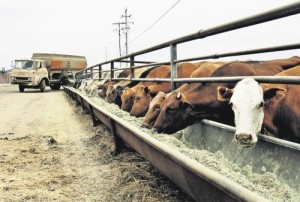In a paper published today in medical journal The Lancet, the authors argue that excessive use of the medication in animals is contributing as much to the global antibiotic resistance crisis as overuse in humans.
 The majority of antibiotics produced by pharmaceutical companies are used in animals rather than humans and there have been outbreaks of antibiotic resistant bacteria in hospitals that have been traced back to bacteria from animals. Although antibiotic use in animals in Europe is tightly regulated, it is less controlled in other parts of the world.
The majority of antibiotics produced by pharmaceutical companies are used in animals rather than humans and there have been outbreaks of antibiotic resistant bacteria in hospitals that have been traced back to bacteria from animals. Although antibiotic use in animals in Europe is tightly regulated, it is less controlled in other parts of the world.
One common means by which antibiotic resistant bugs pass from animal to humans is through eating meat, explained Dr Luke Moore, co-author of the study, from the Department of Medicine at Imperial College London: “If you eat a chicken that contains an antibiotic resistant bacteria, such as E.coli – and the chicken is not cooked properly – the bacteria can lodge in your gut. There is then a risk of it escaping from your intestines, and perhaps travelling to your gallbladder or urinary tract, where it may potentially trigger an infection that doesn’t respond to antibiotics.
“Meat tissue may contain molecules of the antibiotic drug itself. These molecules can travel to your intestines and increase antibiotic resistance in the bacteria that naturally reside in your gut,” he added.
It is not just meat that can carry antibiotic resistance – crops and vegetables can harbour them too, from animal manure used as fertiliser. The researchers suggest that a number of strategies are needed to tackle the issue.
“Farmers have an ever-growing population to feed, and a shrinking area of land to generate food, so they need to meet these demands. We need to not only encourage the use of vaccination, as this would prevent antibiotic use, but also think about how to make immunisation more cost effective for farmers.
We also need to investigate developing alternative methods of killing bacteria – in both humans and animals,” said Dr Moore.
The new paper also reveals that antibiotic resistant bugs will continue to thrive for many years across the globe, even if we immediately stop all use of antibiotics.
The publication is one of a series examining how antimicrobial resistance is being tackled worldwide, and outlining future priorities for researchers and policymakers.
The series is launched today at Imperial, at an event hosted by Imperial’s NIHR Health Protection Research Unit in Healthcare Associated Infection and Antimicrobial Resistance, which is led by Professor Alison Holmes from the Department of Medicine.
Professor Holmes, who is also lead author on the Imperial paper, said: “Our understanding of the mechanisms by which bacteria and other pathogens acquire resistance to drugs suggests that there will be no single solution to the global threat of antimicrobial resistance. We need to tackle this problem synergistically, on multiple fronts, which will require an unprecedented level of international cooperation.”
 Crucially, adds Professor Holmes, researchers and policymakers need to focus their efforts across humans, animals and agriculture, in order to fight the rising tide of resistance.
Crucially, adds Professor Holmes, researchers and policymakers need to focus their efforts across humans, animals and agriculture, in order to fight the rising tide of resistance.
“We must adopt a ‘One Health’ approach globally, recognising that the health of humans, animals and ecosystems are interconnected, and ensuring that any policies to tackle resistance address each of these areas.”
Abstract
To combat the threat to human health and biosecurity from antimicrobial resistance, an understanding of its mechanisms and drivers is needed. Emergence of antimicrobial resistance in microorganisms is a natural phenomenon, yet antimicrobial resistance selection has been driven by antimicrobial exposure in health care, agriculture, and the environment. Onward transmission is affected by standards of infection control, sanitation, access to clean water, access to assured quality antimicrobials and diagnostics, travel, and migration. Strategies to reduce antimicrobial resistance by removing antimicrobial selective pressure alone rely upon resistance imparting a fitness cost, an effect not always apparent. Minimising resistance should therefore be considered comprehensively, by resistance mechanism, microorganism, antimicrobial drug, host, and context; parallel to new drug discovery, broad ranging, multidisciplinary research is needed across these five levels, interlinked across the health-care, agriculture, and environment sectors. Intelligent, integrated approaches, mindful of potential unintended results, are needed to ensure sustained, worldwide access to effective antimicrobials.
Understanding the mechanisms and drivers of antimicrobial resistance
The Lancet
Alison H Holmes, Luke S P Moore, Arnfinn Sundsfjord, Martin Steinbakk, Sadie Regmi, Abhilasha Karkey, Philippe J Guerin, Laura J V Piddock
http://www.thelancet.com/journals/lancet/article/PIIS0140-6736%2815%2900473-0/abstract
